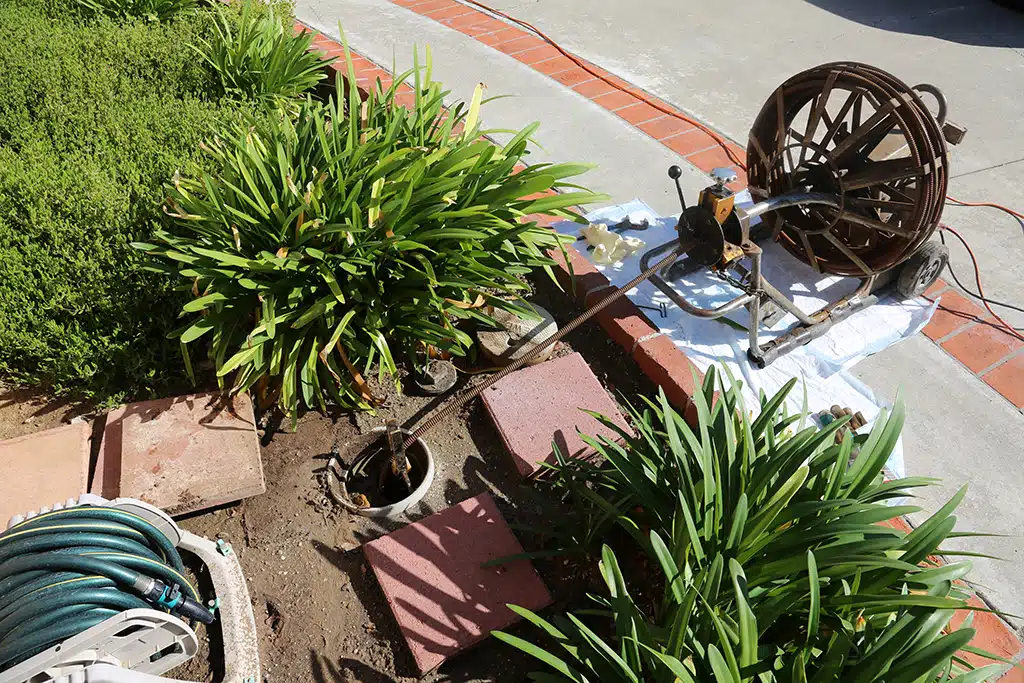There is probably nothing more disgusting than a backed-up drain, except for a backed-up toilet. Whether the blockage is in the sink drain or commode, the reason for the back-up problem might be the same. You need to bring in a trained, professional to investigate, assess, and solve your stinky dilemma.
Step One: Interrogation Of Residents
The first step your plumber takes is to quiz you on what you think might have happened. Did your child flush a dolly or action figure down the commode? Did someone drop a piledriver down the tube? Has anyone poured grease or cooking oil down the kitchen sink? Did you lose a sizeable diamond-studded ring down the bathroom washbasin? Have you just been watching too many horror movies about creatures lurking inside your drain pipes?
We’ll talk more about THINGS NOT TO FLUSH at the end of this blog, so please keep reading.
Once she has picked your brain for possibly nefarious scenarios, that she believes may be at the root of the matter, she may deploy modern-age state-of-the-art technologies to learn more about your stopped-up outflow pipes.
Step Two: What Do I Spy With My Little Camera Eye?
That old saying, “Different strokes for different folks” is undoubtedly true in the plumbing industry. One plumber might be an old-school pro who sends the SNAKE (or auger) down the line first and if that fails, he brings out the more scientific tools.
One tool that is not only space-age and extremely useful is the “camera on a cord,” also known as an endoscope or a borescope. Tampa, FL, has a large population of retired medical professionals, so a plumber here might use the more clinical term endoscope. But when you are out in the wild, the rural hollows, the term borescope is probably more palatable.
If you have ever had an endoscopy procedure performed, such as a knee endoscopy, you know that the doctor makes a small incision and then feeds a tiny tube into the cut. At the front end of the little tube is a tiny camera that allows him to see what is going on in there.
The plumber does the same, minus the incision to the knee. He will feed a camera, attached to a long wire, down the pipe. Performed at the drain/commode itself or additionally, at the outside-accessible clean-out hatch, this action allows him to “see” into your drain line. The plumber can essentially spy into your drain lines anywhere there is an opening into which he may insert the borescope.
Borescopes are especially useful when the mission is not only to clear the clog but also to recover the cause, such as in the case of that large diamond-studded ring. The auger-first method would only blindly push the valued jewelry further down the line. The camera more gingerly determines where the item is located so that the line might be precisely cut open to allow recovery of the valuables without unnecessary damage to the sewer line.
In mystery cases, the borescope is used to determine what exactly is clogging the line. A plumbermight find the local drain line (nearest the sink or commode) free of any debris or plug matter. Despite this, the resident cannot flush without a nasty overflow. By running his borescope down the line, he might determine that a tree root has grown through the line at the rear of the home.
Step Three: Medieval Meets Modern
Let’s assume the Tampa, FLbased plumber has spied a bit of tree root in the line. Your expert plumber may then deploy a battering ram. Well, more like a battering ram attached to a water cannon.
The tool is called a hydro jetter. The tip of this beast looks like a steel fist attached to a long cord. Once fed into the drain line, water jets pulse through the hydro jetter nozzle at around 3500 psi (for most residential applications). It is not the fist-like tip, but the powerful water jets that loosen and break apart the clog, and pushes the smashed residue out into the sewer system.
This highly effective method does quick work of pulverizing any sewer line clog. We recommend that a professional perform this operation as excessive water pressure can do damage to property and cause personal injury.
The industrial hydro jetter units are much more powerful. Transported on flatbed trucks, and sporting multiple, high-volume (500 to 2000 gallon) water tanks, these units blast forth at 10,000 psi to 40,000 psi. That will leave a mark!
What Not To Pour Down A Sink Drain
- Egg Shells
- Flour
- Foodstuffs, especially starchy pasta or rice.
- Milk
- Coffee grounds
- Grease, fats, oils (gravy, mayonnaise, fish oil)
- Urine
- Pharmaceuticals of any kind
- Hair
- Dust, powder
- Insecticides
What Not To Flush Down The Commode
- Condoms
- Feminine pads and tampons
- Cigarette butts
- Paper towels
- Wipes, even the “flushable” kind
- Cotton balls or pads
- Band-aids
- Glass
- Wire
- Coins
- Bottle caps
Some of the above-referenced items will absorb water, expand, clump together, and block your drain. Some coat the inside of the drain and eventually cause a blockage. Solid objects mentioned could rupture your drain pipes, while some of the fluid items are poisonous and not environmentally-friendly.
Contact us today for a free quote. The professional plumber we dispatch will arrive on time and will respect your home or business as if it were his own. Expect a detailed, accurate quote and no surprises. Our reputation is our strength, and we want to earn your trust by performing each task competently. Let us help:
- Protect your pipes from the winter freeze
- Unclog your drains
- Treat lines to prevent clogs
- Service drains to prevent clogs
- Service water system to prevent leaks
- Make common repairs
- Handle emergency service and much, much more
If you live in or own a business in Tampa, FL, please contact Drain Flo Plumbing today. We specialize in affordable solutions for all types of residential and commercial plumbing needs.



